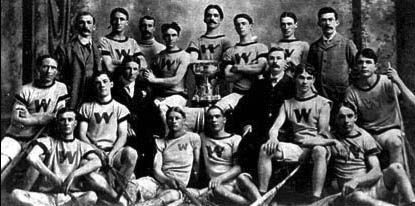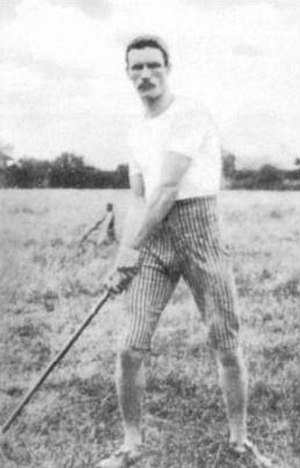Chicago have subsequently bid to host the games in 1952, 1956 and then again for the next Games in 2016, but have yet to earn the right to hold the Games that they were meant to have been hosting in 1904.
Nations 12 (-12)
Competitors 651 (-346)
Sports 17 (-1)
Events 91 (-4)
1 July - 23 November 1904 St. Louis, Mo, USA
So with once again the games being tagged unto the World's Fair they remained spaced out over a number of months. Just as non-Euopean countries were few at the first two Olympiad so the number of European nations dropped for this one, however the Russo-Japanese war made it difficult for some to get to the USA. Those countries that did manage to take part were (with number of athletes in brackets):
- Australia (2)
- Austria (2)
- Canada (52)
- Cuba (3)
- France (1)
- Germany (17)
- Great Britain (3)
- Greece (14)
- Hungary (4)
- South Africa (8)
- Switzerland (1)
- United States (52)
Therefore our ever present nations Australia, France, Great Britain, Greece and Switzerland sent a total of 21 athletes to this games (their lowest combined total). Only 42 of the events, contained competitors who were not from the USA.
Opening ceremony was a disaster. Held on 1 July and the President of the Louisiana Purchase Exposition, David Francis, declined to invite anybody else to open the games. In the end there was a low-key and humdrum opening from a rather disinterested party.
The games themselves were poorly run and almost ended the eight year old Olympic movement stone cold dead. James Edward Sullivan the organiser of the games tried to hold sport event on every day of the four and a half months. But yet again this lead to a spread out programme that people and journalists couldn't really focus on.
However, there were new additions to these games. Some of which have remained more or less ever present some of which have faded away.
Boxing made it debut with seven weight divisions although all of the 18 boxers in the ring came from the USA. Many of the boxers fought in more than one division, some even managing to medal in more than one. Top of the heap was Oliver Kirk who gold medalled in both Bantam and Feather weight. George Finnegan who won the Fly took silver in the Bantam, a feat repeated by Harry Springer (gold Light and silver Welter) and Charles Mayer (Middle and Heavy). The winning of medals at more than one weight in the same games is a feat that has only been achieved by these four men.
Diving appeared for the first time in St. Louis. With two disciplines the first sound familiar and is the platform, the second was the plunge for distance event, which made its only Olympic appearance. However, the two teams for the platform dive had very different opinions into how the event should run and this led to some bitter disputes.
The Germans felt that only the acrobatic content of the dive should be taking into consideration for marking, not the quality of entry or finish. As a result they would perform well in the air but land belly or back first into the Lake. The Americans had a far more graceful conclusion to their dives attempting to enter perpendicular to the waters surface. German Alfred Braunschweiger initially lost the third place dive off and walked off in a huff. Dr Lewald the Imperial High Commissioner to the World's Fair thus refused initially to provide the statuette to to the winner and George Sheldon the American winner refused to accept his winners reward once the dispute was sorted out and a second bronze was awarded.
The plunge for distance for competition to see how far someone could go from initial dive into the pool without propulsion from arms or legs, face down in the water, see how far they could get in 60 seconds.
Lacrosse made the first of its five Olympic appearances at St. Louis (though the last three as a demonstration sport only). Two teams from Canada (one entirely of Mohawk Indians, the other from the Shamrock Athletic Club) took on a local St. Louis team. In the end the Irish/Canadian Club beat the American's in the final.
Roque as similar mallet sport to croquet replaced it at the 1904 games. Making its only appearance as an Olympic sport. It is played on a raised hard sand or clay surface which is walled. The walls could be used like the cushions of a snooker table to play off. The club that hit the balls had an Octogan head to it. But the aim to hit the ball through a double diamond of arches is very similar to croquet. The sport itself is now obsolete with its governing body ceasing to exist in 1970.
Athletics managed to see it a major controversy and the advent of a new sport.
The controversy came in the Marathon when the first runner to re-enter the Olympic stadium was Frederick Lorz. He had stopped running due to exhaustion after 9 km, then got into the car of his manager until that broke down and then jogged back to the stadium to pick up his kit. As he got there the cheers went up so he ran up to break the tape and was hailed the winner. He was given a life ban but which was later lifted when he apologised saying he never meant to defraud and went on to win the 1905 Boston Marathon. The winner therefore for Tom Hicks, who stopped to walk for part of the course and was given a strychnine shot (now a banned substance) to complete the course. In silver was Albert Corey, who was a French born runner living in new York, but because he had insufficient documentation he is listed as USA not France for his medal, though in the 4 mile mens race the Chicago AA team is deemed to be mixed because of the presence of Corey.
The advent though was for the Decathalon. Although the 10 events were a little different from what we know today.
However, there were new additions to these games. Some of which have remained more or less ever present some of which have faded away.
 |
| Oliver Kirk the only man to win 2 boxing golds at one Games |
Diving appeared for the first time in St. Louis. With two disciplines the first sound familiar and is the platform, the second was the plunge for distance event, which made its only Olympic appearance. However, the two teams for the platform dive had very different opinions into how the event should run and this led to some bitter disputes.
The Germans felt that only the acrobatic content of the dive should be taking into consideration for marking, not the quality of entry or finish. As a result they would perform well in the air but land belly or back first into the Lake. The Americans had a far more graceful conclusion to their dives attempting to enter perpendicular to the waters surface. German Alfred Braunschweiger initially lost the third place dive off and walked off in a huff. Dr Lewald the Imperial High Commissioner to the World's Fair thus refused initially to provide the statuette to to the winner and George Sheldon the American winner refused to accept his winners reward once the dispute was sorted out and a second bronze was awarded.
 |
| The first Olympic Lacrosse champions |
Lacrosse made the first of its five Olympic appearances at St. Louis (though the last three as a demonstration sport only). Two teams from Canada (one entirely of Mohawk Indians, the other from the Shamrock Athletic Club) took on a local St. Louis team. In the end the Irish/Canadian Club beat the American's in the final.
| A view of some roque courts |
Athletics managed to see it a major controversy and the advent of a new sport.
The controversy came in the Marathon when the first runner to re-enter the Olympic stadium was Frederick Lorz. He had stopped running due to exhaustion after 9 km, then got into the car of his manager until that broke down and then jogged back to the stadium to pick up his kit. As he got there the cheers went up so he ran up to break the tape and was hailed the winner. He was given a life ban but which was later lifted when he apologised saying he never meant to defraud and went on to win the 1905 Boston Marathon. The winner therefore for Tom Hicks, who stopped to walk for part of the course and was given a strychnine shot (now a banned substance) to complete the course. In silver was Albert Corey, who was a French born runner living in new York, but because he had insufficient documentation he is listed as USA not France for his medal, though in the 4 mile mens race the Chicago AA team is deemed to be mixed because of the presence of Corey.
 |
| Tom Keily first decathlon gold |
- 100 yard dash
- Shot put
- High jump
- 880 yard walk
- Hammer throw
- Pole vault
- 120 yard hurdles
- 56 pound weight throw
- Long jump
- 1 mile
Apart from the distance changes to 100m, 110m hurdles and 1500m the modern decathletes thrown a javelin instead of the hammer, a discus instead of the 56 pound weight and take a 400m sprint instead of the 880 yard walk. The first winner was Tom Kiely, he is listed as team GB, however the man from Carrick-on-Suir was a staunch Irish nationalist who had turned down offers both from the British Olympic Committee and a American sponsor to make his way to St. Louis. In the end he made it under his own steam and carried on claiming that he was there to represent Ireland. However, as Ireland was not yet independent the records record him as being British. He was not the first Irishman, nor nationalist, to win an Olympic Gold medal, indeed John Pius Boland in the tennis in 1896 takes that honour. But he was the first to try and vocally make a point of it. Indeed the only other medal won by GB in 1904 was by John Daly from Galway in the 2000m steeplechase.
But the decathlon was an event created for the Olympics and apart from the next games in 1908 it has been a permanent feature in the games ever since.
However, the games though there were notable individual exceptions overall were mediocre as a spectacle. The IOC had to do something to ensure their survival. But more about that next week.
See also my full history of past Olympics here.
See also my full history of past Olympics here.

No comments:
Post a Comment